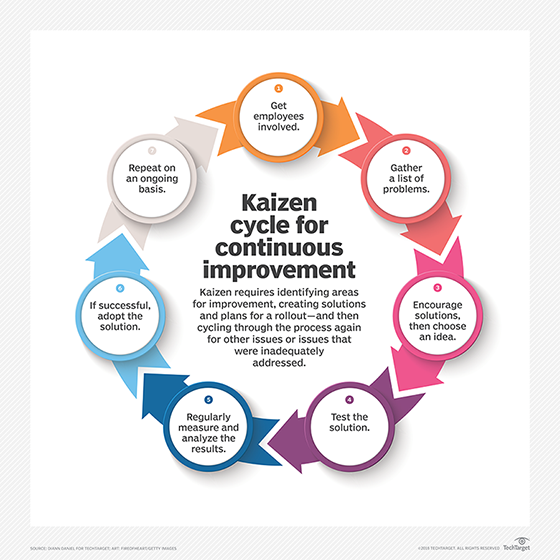Total Quality Management (TQM) (original) (raw)
Total Quality Management (TQM) is a management framework based on the belief that an organization can build long-term success by having all its members -- from low-level workers to its highest-ranking executives -- focus on improving quality and, thus, delivering customer satisfaction.
This management approach is used to simplify supply chain management, as well as to detect, reduce or remove errors. TQM requires organizations to focus on continuous improvement, or Kaizen. TQM focuses on continual internal and process improvements over the long term, thereby enhancing the quality of produced products or services.

TQM requires organizations to focus on continuous improvement, or Kaizen.
All departments that contribute to the creation of a product or service -- including design, engineering and marketing teams -- participate in TQM. Management acts as a facilitator by providing quality staffing and training and setting goals.
TQM has no single agreed-upon approach but does follow eight guiding principles that focus on improving quality.
Importance of TQM
TQM can have a beneficial effect on employee and organizational development. By having all employees focus on quality management and continuous improvement, companies can establish and uphold cultural values that create long-term success for both customers and the organization. TQM's focus on quality helps organizations identify skill deficiencies in employees, along with the necessary training, education or mentoring required to address those needs.
With a focus on teamwork, TQM leads to the creation of cross-functional teams and knowledge sharing. The increased communication and coordination across disparate groups deepens institutional knowledge and gives companies more flexibility in deploying personnel.
Principles of TQM
TQM prescribes a series of ways for organizations to accomplish this, with the pathway to successful continuous improvement centered on the use of strategy, data and effective communication to instill a discipline of quality into the organization's culture and processes.
More specifically, TQM highlights the processes that organizations use to produce their products, and it calls for organizations to define those processes, continuously monitor and measure their performance, and use that performance data to drive improvements. In addition, it requires all employees and organizational departments to be part of this process. The eight guiding principles that TQM uses to improve quality include the following:
- Customer focus. The customer determines the quality level of the products and services. Customer input is valued, as it provides a better understanding of what the customer needs.
- Employee involvement. All employees must participate in the processes and system. They must be properly trained and given the needed resources to complete their tasks on time.
- Focus on process. Processes must be continually analyzed to identify weaknesses. Every employee who takes part in the process should be properly educated in their contributions, ensuring the right steps are taken at the right time.
- Integrated business systems. All TQM processes should be integrated into a business process. Integrated systems convey potentially useful data across departments, enabling everyone to be on the same page.
- Strategic and systematic approach. Planning and management are required using a strategic plan with quality as a base component.
- Continual improvement. A focus on continually improving quality helps an organization adapt to changing markets and achieve competitive advantages.
- Focus on data. Data should be collected, documented and analyzed to improve decision-making accuracy and to predict trends based on previous history.
- Communication. Communication between teams with information such as strategies, methodologies or timeliness is essential to improving operations. Good communication can also motivate employees and improve morale.
Implementation principles and processes
The general process of implementing TQM follows these steps:
- The organization assesses its current culture and quality management systems and identifies core values.
- Management decides to commit to TQM and develops a TQM master plan.
- The organization identifies and prioritizes customer demands.
- Management maps the processes needed to meet customer needs.
- Management creates a team to oversee efforts to improve processes.
- Management starts contributing to the process by providing additional planning and training.
- Management creates a process to standardize daily process management.
- Management continually asks employees for feedback.
Implementing TQM is a long-term commitment, and the length of time needed for planning, development and implementation varies by organization.
Benefits of TQM
TQM offers the following benefits:
- Less product defects . An objective of TQM is to create products and services correctly the first time. This means that products ship with fewer defects, reducing product recalls, future customer support overhead and product fixes.
- Satisfied customers . High-quality products that meet customers' needs result in higher customer satisfaction. High customer satisfaction, in turn, can lead to increased market share, revenue growth via upselling and word-of-mouth marketing initiated by customers.
- Lower costs . As a result of less product defects, companies save money on customer support, product replacements, field service and creating product fixes. The cost savings flow to the bottom line, creating higher profit margins.
- Well-defined cultural values . Organizations that practice TQM develop and nurture core values around quality management and continuous improvement. The TQM mindset pervades across all aspects of an organization, from hiring to internal processes to product development.
Disadvantages of TQM
The downsides of TQM include the following:
- Planning and resources. TQM needs a significant amount of planning and resources over time to be properly allocated to the change.
- Companywide commitment. Continuous improvement in TQM means the organizational culture must focus on improving processes. All management levels must be supportive.
- Added costs. TQM might add training, infrastructure and team development costs.
- Time. It might take years for an organization to fully show intended results.
- Partial efforts. Because of the effort involved in implementing TQM, a partial move toward it can result in failure.
Examples of TQM
Automobile manufacturer Toyota exemplifies TQM. The adoption of TQM and Kaizen at Toyota led to higher product and work quality at all levels of the organization. Toyota adopted a related practice called statistical quality control in 1949. In 1951, Toyota launched the Creative Idea Suggestion System, which was based on a suggestion system used at Ford.
In 1965, Toyota was awarded the Deming Application Prize for major advances in quality improvement. In 1994, the "Toyota Group Executive TQM Training Course" was established, providing TQM training for new executives. Toyota's TQM initiatives continue to the present day. In 2011, Toyota announced that its Creative Idea Suggestion System had generated more than 40 million suggestions to date.
Another example of TQM occurred at Tata Steel, a steel-making company based in India and a subsidiary of Tata Group. Tata Steel adopted TQM in the 1980s. The company was awarded the Deming Application Prize in 2008. Tata Steel used TQM methodologies to gain a deep understanding of customers. They sought to ensure value creation in a system that covered customers and suppliers.
In 2008, Tata Steel created the Performance Improvement Committee to drive continuous performance improvement. Performance Improvement Groups were established for iron making, steel making, flat rolling, long rolling, maintenance and more.
As part of its 2008-2009 annual report, Tata Steel reported that its TQM initiatives resulted in a $150 million bottom-line effect on its business.
History of TQM
TQM dates back to the 1920s when the science of statistics was applied to Quality control in an industrial setting. Walter A. Shewhart, an engineer at Western Electric and Bell Telephone Laboratories, created a statistical control chart in the mid-1920s and then published Economic Control of Quality of Manufactured Product in 1931. Although the PDCA -- plan-do-check-act -- model is often called the Deming Cycle, Deming himself credited Shewhart with its creation. Deming later went on to advocate for a plan-do-study-act model.

Dr. W. Edwards Deming, the father of modern quality control, developed the Deming circle for continuous improvement.
Quality control methods evolved in subsequent decades, with industrial engineer Joseph Juran first employing Shewhart's methods and, later, in 1951, publishing his influential book, Juran's Quality Control Handbook.
Deming further developed Shewhart's ideas in post-World War II Japan, where the U.S. government had positioned him to advise Japanese leaders on the rebuilding efforts taking place there in the late 1940s and 1950s. Working with the Union of Japanese Scientists and Engineers, Deming taught and lectured on statistical quality control, while adding his own ideas about quality control in the process. Among these teachings was Deming's belief that ordinary workers had a role to play in quality control.
The method that evolved during the 1950s and 1960s eventually became known as Total Quality Management. Many credit the Japanese application of TQM as a significant contributor to the country's economic recovery following World War II, as well as its midcentury industrial successes.
Organizations worldwide took note of Japan's successes using TQM. U.S. producers throughout the 1970s and 1980s adopted quality and productivity methods, including TQM, to better compete in the increasingly global marketplace.
Although Deming, Juran, Shewhart and others published numerous papers and books on TQM, many organizations adopted different TQM trends or only parts of the TQM principles and evolved some of TQM's ideas to meet their own needs.
Moreover, as business needs for efficiency, productivity and quality have further evolved, many organizations have adopted other, more modern management techniques. Although TQM is still influential, other management techniques, such as Six Sigma and lean manufacturing, which better address organizational goals for the 21st century, have replaced it in many businesses.
Learn more about the benefits of continuous improvement processes and how a model-based approach contributes to creating a strong enterprise architecture.
This was last updated in April 2023
Continue Reading About Total Quality Management (TQM)
- How lean production systems cut the fat out of manufacturing, ERP
- Agile vs. Waterfall: What's the difference?
- Scrum vs. Kanban: What's the difference?
- Top 10 business process management certifications
- The importance of improving data quality at source
 What is quality assurance (QA)? By: Cameron Hashemi-Pour
What is quality assurance (QA)? By: Cameron Hashemi-Pour  What is PDCA (Plan, Do, Check, Act)?
What is PDCA (Plan, Do, Check, Act)?  By: Katie Terrell Hanna
By: Katie Terrell Hanna  How to improve and optimize a business process, step by step
How to improve and optimize a business process, step by step  By: Ronald Schmelzer
By: Ronald Schmelzer  business process improvement (BPI)
business process improvement (BPI)  By: Mary Pratt
By: Mary Pratt